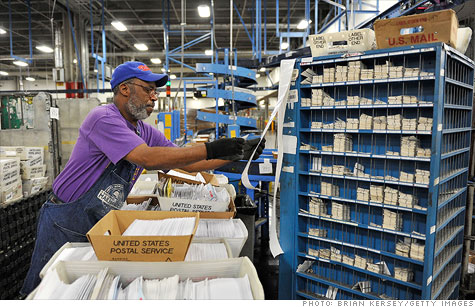Search News

The Postal Service says it could reach its $15 billion debt limit and run out of cash this year.
WASHINGTON (CNNMoney) -- A nickel boost in the first-class stamp price to 50 cents is part of the U.S. Postal Service's latest plan to stop bleeding red ink.
The Postal Service released the 5-year business plan to Congress late Thursday in part to push Congress to pass legislation to help them get through ongoing financial woes. Due in large part to declining first-class mail volume, the service recorded a $3.3 billion loss in the final three months of last year, which is usually a profitable period.

The Postal Service says that, if nothing is done, it faces $18 billion in losses by 2015. Lawmakers have been working on different plans for months, but all of them have controversial aspects and are stalled.
The U.S. Postal Service's plan would save about $20 billion over the next five years, although it needs Congress to act to achieve about $10 billion in savings.
Nearly all the ideas in the five-year plan have been proposed before, except for the big first-class stamp boost. Raising the price of the stamp to 50 cents from 45 cents now could yield $1 billion a year in new revenue, according to the plan.
Among previously offered proposals, home delivery would be cut to five days a week from six, and thousands of post offices and mail processing plants would be closed. The service would slow the delivery of first class mail by a day.
The agency also proposes bypassing a federal law that requires that it to prefund retiree health care. It would also create a new health care plan for employees to be run by the Postal Service.
The plan would also reduce the number of employees by 155,000 by 2016, mostly through pushing some of the 283,000 eligible to retire.
"The plan we have developed requires a combination of aggressive cost reduction, rethinking the way we manage our healthcare costs, and comprehensive legislation to reform the business model of the Postal Service," said Postmaster General Patrick Donahoe.
However, most of the cost-cutting measures the Postal Service is pushing for are controversial, and have opponents in Congress and among employee unions.
The National Association of Letter Carriers vowed to study the new business plan but decried moves to cut Saturday delivery, downsize networks and slow delivery.
"Charging more for reduced service is not a rational plan for any business, including the U.S. Postal Service," said Fredric Rolando, president of the National Association of Letter Carriers.
The union also noted that almost all of the $3.3 billion in red ink the Postal Service recorded in the quarter resulted from the $3.1 billion owed to pre-fund future retiree health benefits. The union wants Congress to dispense with the 2006 mandate that required prefunding those benefits.
In December, the Postal Service announced a plan to shut up to 250 mail processing plants and cut 28,000 jobs nationwide, but later delayed the closures until May 15. The plan released Friday makes clear the Postal Service intends to push forward with proposed cuts if Congress doesn't act.
Postal Service policy consultant Alan Robinson noted that the new business plan includes an "aggressive schedule" for cutting employees and services, in his blog the Courier Express and Postal Observer.
The plan to cut mail facilities soon after the May 15 moratorium "represents a clear example of the Postal Service taking an action that will generate substantial political heat that in previous years it would have deferred," Robinson wrote.
As for when Congress might act, experts say they don't expect progress until March at the earliest.
"This is a dire situation, but it is not hopeless," said Sen. Tom Carper, a Delaware Democrat who runs the subcommittee that oversees the U.S. Postal Service. "We can save the Postal Service for future generations -- and without further burdening taxpayers -- if we act decisively and strategically."
The Postal Service is chartered as a government enterprise and its business model is supposed to be self-sufficient. But it has borrowed $12.9 billion from Treasury in recent years to stave off cash crunches. ![]()
| Overnight Avg Rate | Latest | Change | Last Week |
|---|---|---|---|
| 30 yr fixed | 3.80% | 3.88% | |
| 15 yr fixed | 3.20% | 3.23% | |
| 5/1 ARM | 3.84% | 3.88% | |
| 30 yr refi | 3.82% | 3.93% | |
| 15 yr refi | 3.20% | 3.23% |
Today's featured rates:
| Latest Report | Next Update |
|---|---|
| Home prices | Aug 28 |
| Consumer confidence | Aug 28 |
| GDP | Aug 29 |
| Manufacturing (ISM) | Sept 4 |
| Jobs | Sept 7 |
| Inflation (CPI) | Sept 14 |
| Retail sales | Sept 14 |